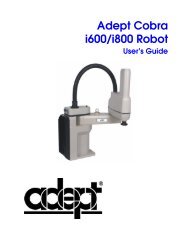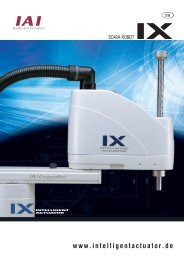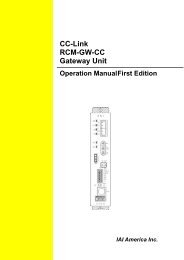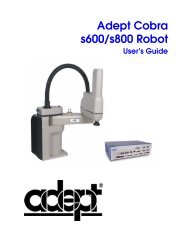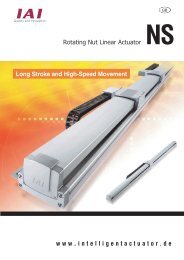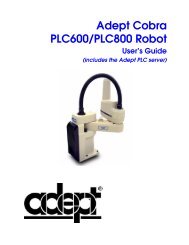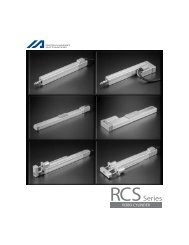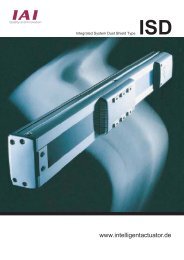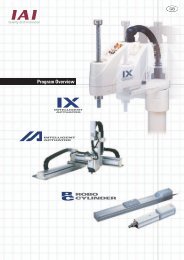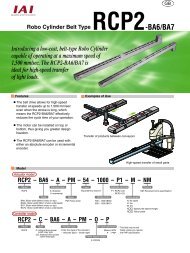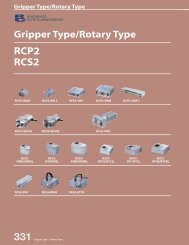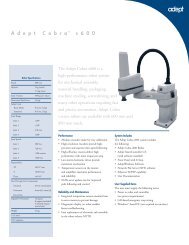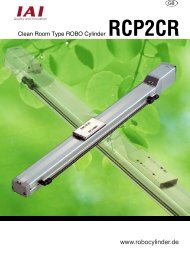PCON-C/CG Controller Positioner Type - pulsar.com.tr
PCON-C/CG Controller Positioner Type - pulsar.com.tr
PCON-C/CG Controller Positioner Type - pulsar.com.tr
Create successful ePaper yourself
Turn your PDF publications into a flip-book with our unique Google optimized e-Paper software.
• Explanation of each switch<br />
[1] Address switch<br />
If multiple axes are used, the PC/teaching pendant must be plugged into/out of different connectors<br />
to <s<strong>tr</strong>ong>com</s<strong>tr</strong>ong>municate with different axes.<br />
To save the hassle, you can use link cables to connect all axes via SIO converters.<br />
Under this method, however, the PC/teaching pendant must be able to identify each axis by the<br />
number assigned to the axis.<br />
This switch is used to set this number.<br />
For details, refer to Chapter 9, “How to Connect a PC/Teaching Pendant to Multiple Axes.”<br />
[2] Mode selector switch<br />
This interlock switch is used to prevent unexpected movement or data rewrite as a result of duplicate<br />
operation in which a movement <s<strong>tr</strong>ong>com</s<strong>tr</strong>ong>mand is input from the PLC and operation using the PC/teaching<br />
pendant is performed at the same time.<br />
AUTO: Always set to the “AUTO” side during auto operation using PIO signals from the PLC.<br />
MANU: Always set to the “MANU” side during operation using the PC/teaching pendant.<br />
[3] Brake release switch<br />
When the actuator is equipped with a brake, this switch is used to forcibly release the brake.<br />
RLS: Forcibly release the brake<br />
NOR: Normal setting (The brake is released by the con<strong>tr</strong>oller.)<br />
Warning: The load may suddenly drop when the brake is forcibly released, so exercise due caution<br />
not to pinch your hand or damage the robot hand by the falling load.<br />
• Explanation of power-supply terminal block<br />
[1] <s<strong>tr</strong>ong>PCON</s<strong>tr</strong>ong>-C [Internal drive-power cutoff relay type]<br />
Provide a contact output for the emergency-stop button on the teaching pendant.<br />
S1, S2 * Whether or not a teaching pendant is connected is determined by an internal<br />
circuit. If no teaching pendant is connected, the S1 and S2 terminals are closed.<br />
MPI, MPO<br />
24V<br />
0V<br />
EMG-<br />
Provide a contact for cutting off the motor drive power. MPI and MPO represent the<br />
input side and output side of the motor power supply, respectively. (Short these<br />
terminals using a jumper wire if not used. The con<strong>tr</strong>oller is shipped with MPI and MPO<br />
shorted.)<br />
Positive side of the 24-VDC input power supply<br />
Negative side of the 24-VDC input power supply<br />
Emergency-stop input<br />
[2] <s<strong>tr</strong>ong>PCON</s<strong>tr</strong>ong>-<s<strong>tr</strong>ong>CG</s<strong>tr</strong>ong> [External driver-power cutoff relay type]<br />
Provide a contact output for the emergency-stop button on the teaching pendant.<br />
S1, S2 * Whether or not a teaching pendant is connected is determined by an internal<br />
circuit. If no teaching pendant is connected, the S1 and S2 terminals are closed.<br />
MPI, MPO<br />
24V<br />
0V<br />
EMG-<br />
Motor drive-power cutoff contacts conforming to safety category 1<br />
MPI and MPO represent the input side and output side of the motor power supply,<br />
respectively. (Connect an external safety circuit.)<br />
Positive side of the 24-VDC input power supply<br />
Negative side of the 24-VDC input power supply<br />
Emergency stop signal detection<br />
10



